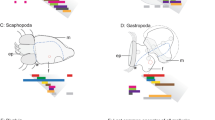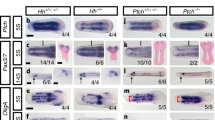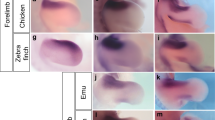Abstract
The evolution of snakes involved major changes in vertebrate body plan organization, but the developmental basis of those changes is unknown. The python axial skeleton consists of hundreds of similar vertebrae, forelimbs are absent and hindlimbs are severely reduced. Combined limb loss and trunk elongation is found in many vertebrate taxa1, suggesting that these changes may be linked by a common developmental mechanism. Here we show that Hox gene expression domains are expanded along the body axis in python embryos, and that this can account for both the absence of forelimbs and the expansion of thoracic identity in the axial skeleton. Hindlimb buds are initiated, but apical-ridge and polarizing-region signalling pathways that are normally required for limb development are not activated. Leg bud outgrowth and signalling by Sonic hedgehog in pythons can be rescued by application of fibroblast growth factor or by recombination with chick apical ridge. The failure to activate these signalling pathways during normal python development may also stem from changes in Hox gene expression that occurred early in snake evolution.
This is a preview of subscription content, access via your institution
Access options
Subscribe to this journal
Receive 51 print issues and online access
$199.00 per year
only $3.90 per issue
Buy this article
- Purchase on Springer Link
- Instant access to full article PDF
Prices may be subject to local taxes which are calculated during checkout





Similar content being viewed by others
References
Carroll, R. Vertebrate Paleontology and Evolution(Freeman, New York, (1988).
Lee, M. S. Y. & Caldwell, M. W. Anatomy and relationships of Pachyrhachis problematicus, a primitive snake with hindlimbs. Phil. Trans. R. Soc. Lond. B 353, 1521–1552 (1998).
Gaunt, S. J. Conservation in the Hox code during morphological evolution. Int. J. Dev. Biol. 38, 549–552 (1994).
Burke, A. C., Nelson, C. E., Morgan, B. A. & Tabin, C. Hox genes and the evolution of vertebrate axial morphology. Development 121, 333–346 (1995).
Cohn, M. J.et al. Hox9 genes and vertebrate limb specification. Nature 387, 97–101 (1997).
Rancourt, D. E., Tsuzuki, T. & Capecchi, M. R. Genetic interaction between Hoxb-5 and Hoxb-6 is revealed by nonallelic noncomplementation. Genes Dev. 9, 108–122 (1995).
Oliver, G., Wright, C. V., Hardwicke, J. & De Robertis, E. M. Differential antero-posterior expression of two proteins encoded by a homeobox gene in Xenopus and mouse embryos. EMBO J. 7, 3199–3209 (1988).
Shashikant, C. S.et al. Regulation of Hoxc-8 during mouse embryonic development: identification and characterization of critical elements involved in early neural tube expression. Development 121, 4339–4347 (1995).
Wall, N. A., Jones, C. M., Hogan, B. L. & Wright, C. V. Expression and modification of Hox 2.1 protein in mouse embryos. Mech. Dev. 37, 111–120 (1992).
Oliver, G., De Robertis, E. M., Wolpert, L. & Tickle, C. Expression of a homeobox gene in the chick wing bud following application of retinoic acid and grafts of polarizing region tissue. EMBO J. 9, 3093–3099 (1990).
Nelson, C. E.et al. Analysis of Hox gene expression in the chick limb bud. Development 122, 1449–1466 (1996).
Saunders, J. W. The proximo-distal sequence of origin of the parts of the chick wing and the role of the ectoderm. J. Exp. Zool. 108, 363–402 (1948).
Fang, H. & Elinson, R. P. Patterns of distal-less gene expression and inductive interactions in the head of the direct developing frog Eleutherodactylus coqui. Dev. Biol. 179, 160–172 (1996).
Ferrari, D.et al. The expression pattern of the Distal-less homeobox-containing gene Dlx-5 in the developing chick limb bud suggests its involvement in apical ectodermal ridge activity, pattern formation, and cartilage differentiation. Mech. Dev. 52, 257–264 (1995).
Savage, M. P.et al. Distribution of FGF-2 suggests it has a role in chick limb bud growth. Dev. Dyn. 198, 159–170 (1993).
Davidson, D. R., Crawley, A., Hill, R. E. & Tickle, C. Position-dependent expression of two related homeobox genes in developing vertebrate limbs. Nature 352, 429–431 (1991).
Niswander, L., Jeffrey, S., Martin, G. R. & Tickle, C. Apositive feedback loop coordinates growth and patterning in the vertebrate limb. Nature 371, 609–612 (1994).
Laufer, E., Nelson, C. E., Johnson, R. L., Morgan, B. A. & Tabin, C. Sonic hedgehog and Fgf-4 act through a signaling cascade and feedback loop to integrate growth and patterning of the developing limb bud. Cell 79, 993–1003 (1994).
Raynaud, A., Kan, P., Bouche, G. & Duprat, A. M. Fibroblast growth factors (FGF-2) and delayed involution of the posterior limbs of the slow-worm embryo (Anguis fragilis, L.). C. R. Acad. Sci. 318, 573–578 (1995).
Altabef, M., Clarke, J. D. W. & Tickle, C. Dorso-ventral ectodermal compartments and origin of apical ectodermal ridge in developing chick limb. Development 124, 4547–4546 (1997).
Zeller, R. & Duboule, D. Dorso-ventral limb polarity and origin of the ridge: on the fringe of independence? BioEssays 19, 541–546 (1997).
Davis, C. A., Holmyard, D. P., Millen, K. J. & Joyner, A. L. Examining pattern formation in mouse, chicken and frog embryos with an En-specific antiserum. Development 111, 287–298 (1991).
Riddle, R. D.et al. Induction of LIM homeobox gene Lmx-1 by WNT7a establishes dorsoventral pattern in the vertebrate limb. Cell 83, 631–640 (1995).
Chiang, C.et al. Cyclopia and defective axial patterning in mice lacking Sonic hedgehog gene function. Nature 383, 407–413 (1996).
Marti, E., Takada, R., Bumcrot, D. A., Sasaki, H. & McMahon, A. P. Distribution of Sonic hedgehog peptides in the developing chick and mouse embryo. Development 121, 2537–2547 (1995).
Marigo, V., Scott, M. P., Johnson, R. L., Goodrich, L. V. & Tabin, C. J. Conservation in hedgehog signaling: induction of a chicken patched homolog by Sonic hedgehog in the developing limb. Development 122, 1225–1233 (1996).
Yang, Y.et al. Relationship between dose, distance and time in Sonic Hedgehog -mediated regulation of anteroposterior polarity in the chick limb. Development 124, 4393–4404 (1997).
Charite, J., de Graaff, W., Shen, S. & Deschamps, J. Ectopic expression of Hoxb-8 causes duplication of the ZPA in the forelimb and homeotic transformation of axial structures. Cell 78, 589–601 (1994).
Geduspan, J. S. & MacCabe, J. A. Transfer of dorsoventral information from mesoderm to ectoderm at the onset of limb development. Anat. Rec. 224, 79–87 (1989).
Wilson, V. & Beddington, R. Expression of T protein in the primitive streak is necessary and sufficient for posterior mesoderm movement and somite differentiation. Dev. Biol. 192, 45–58 (1997).
Panganiban, G., Sebring, A., Nagy, L. & Carroll, S. The development of crustacean limbs and the evolution of arthropods. Science 270, 1363–1366 (1995).
Gasc, J.-P. Les rapports anatomiques du membre pelvien vestigial chez les squamates serpentiformes. Bull. Mus. Nat. Hist. 2e Ser. 38, 99–110 (1966).
Eyewitness Encyclopedia of Nature.(Dorling-Kindersley Multimedia, London, (1995).
Acknowledgements
We thank Drayton Manor Zoo, Edinburgh Zoo, London Zoo, Welsh Mountain Zoo and J. Fletcher for fertile python eggs; M. Caldwell, A. Cohn, S. Evans, M. Ferguson, E. Kochva, M. Lee, C.O. Lovejoy, K. Patel, J. R. D. Stalvey, V. Wilson and L. Wolpert for discussion; M. Turmaine for assistance with scanning electron microscopy; and E. De Robertis, T. Jessell, A. Joyner, G. Martin, A.McMahon, G. Panganiban, C. Tabin, N. Wall, and R. Zeller for reagents. This research was funded by the BBSRC.
Author information
Authors and Affiliations
Corresponding author
Rights and permissions
About this article
Cite this article
.Cohn, M., Tickle, C. Developmental basis of limblessness and axial patterning in snakes. Nature 399, 474–479 (1999). https://doi.org/10.1038/20944
Received:
Accepted:
Issue Date:
DOI: https://doi.org/10.1038/20944
This article is cited by
-
Snake-like limb loss in a Carboniferous amniote
Nature Ecology & Evolution (2022)
-
Gene expression changes during the evolution of the tetrapod limb
Biologia Futura (2022)
-
Evo-Devo Path as a Bridge between Evolution, Morphological Disparity, and Medicine with Comments on “Hopeful Monsters” in the Age of Genomics
Current Molecular Biology Reports (2020)
-
Recapitulation-like developmental transitions of chromatin accessibility in vertebrates
Zoological Letters (2019)
-
The evolution of the axial skeleton intercentrum system in snakes revealed by new data from the Cretaceous snakes Dinilysia and Najash
Scientific Reports (2019)
Comments
By submitting a comment you agree to abide by our Terms and Community Guidelines. If you find something abusive or that does not comply with our terms or guidelines please flag it as inappropriate.



